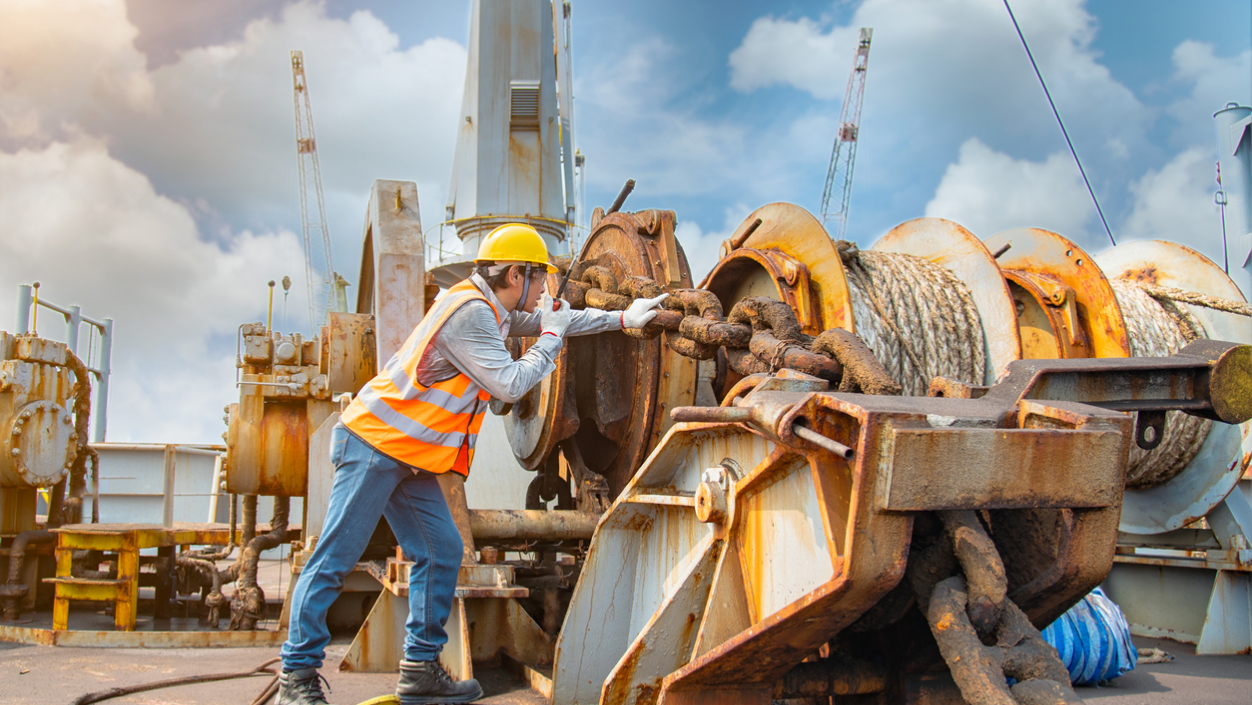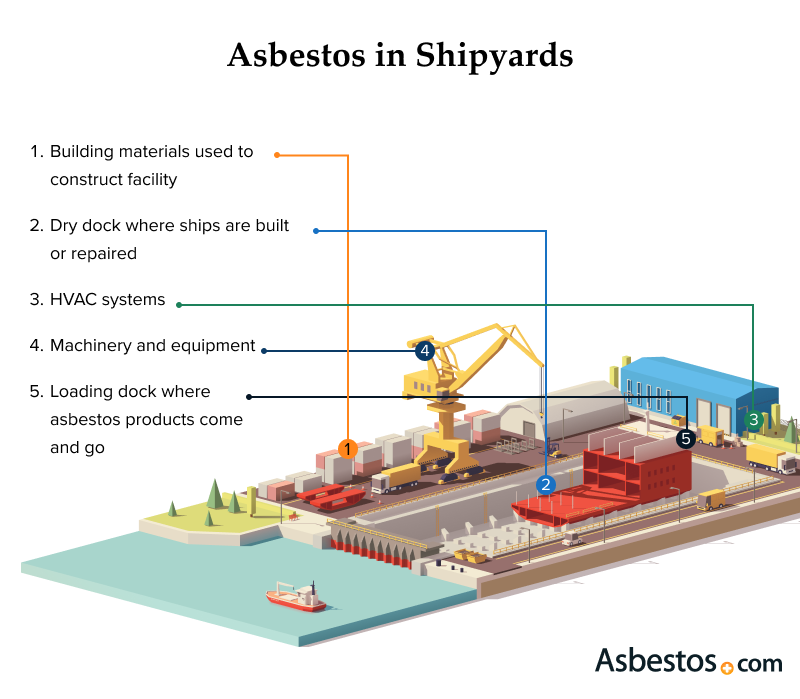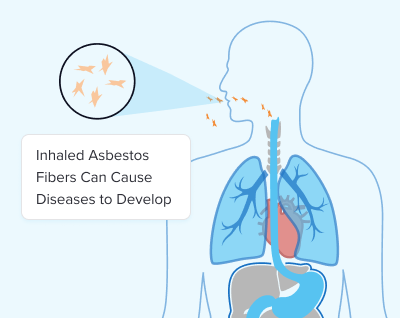Shaun Bigbie’s father worked at the Ford Motor Company in Norfolk, Virginia. He had also worked at the Norfolk Naval Shipyard in Portsmouth, Virginia. Both are known for a high risk of asbestos exposure. Shaun tells us that he also worked at both locations where his father had worked. This could mean that he and his father have shared occupational asbestos exposure or primary exposure histories.
Shipyard Workers and Asbestos
Shipyard workers suffer higher rates of mesothelioma, lung cancer and asbestosis because asbestos products were used in nearly every part of shipbuilding. U.S. veterans were exposed in Navy shipyards and civilians were exposed in commercial shipyards to asbestos insulation, gaskets, pumps and pipes.

How Are Shipyard Workers Exposed to Asbestos?
Cutting, drilling, handling and sanding asbestos materials exposed shipyard workers. Such activities released dust with asbestos fibers into the air. Inhalation of these fibers occurred through both direct and indirect means. The fibers traveled beyond their origin to expose workers in other areas.
Repeated exposure increases the risk of workers developing mesothelioma. Historically, many shipbuilding components used asbestos. The mineral resists corrosion by ocean water. Engine gaskets, seals and pipe insulation used asbestos for its strength and fire resistance.
Shipyard building materials also contributed to occupational exposure. Asbestos panels were common in yard equipment and in buildings.
Commercial ships may contain up to 10 tons of asbestos. U.S. Navy vessels may have up to 900 tons of asbestos. A 2021 survey of vessels found that more than 55% of in-service ships and 50% of new builds contain asbestos. Regulations to reduce asbestos use in ships have failed to protect workers.

Asbestos Products Associated with Shipyard Workers
Shipyards used asbestos products for most of the 20th century. Insulation, gaskets, seals, brakes and cement had asbestos. Before 1975, the U.S. Navy relied heavily on asbestos materials throughout its vessels. Shipbuilders used asbestos in engine rooms, sleeping quarters and boiler rooms.
A 1975 regulation limited its use when alternatives were available. In 1979, an amendment urged the removal of some asbestos insulation. Workers exposed prior to these regulations are still developing diseases now. Mesothelioma has a long latency period of up to 60 years.
Most U.S. manufacturers have now phased out asbestos from their products. But workers may still find it in older materials in shipyards today. Widespread use meant many shipyard workers faced a risk. They remain at risk of developing asbestos-related illnesses.
Manufacturers of Products Shipyard Workers Use
Johns-Manville was a top maker of asbestos shipbuilding materials. Others include Burnham Holdings, Foster Wheeler and Pryor Giggey Co.
Asbestos Companies
Manufacturers tried to blame shipyard asbestos exposure on the U.S. Navy. Laws protect the Navy from asbestos lawsuits. Shipyard workers who develop mesothelioma instead hold asbestos manufacturers liable for the disease. Courts have held shipyard owners and operators liable as well.

Learn about mesothelioma, asbestos exposure in the military, top treatment options and more.
Get Yours NowShipyard Workers & Asbestos-Related Diseases

Shipyard workers are at increased risk of developing mesothelioma and other asbestos-related diseases. A 2024 study in the Annals of Work Exposures and Health analyzed asbestos fibers in the lung tissue of individuals who died from mesothelioma. It uncovered a direct correlation between the amount of asbestos and the risk of mesothelioma in shipyard workers.
Another 2024 study found that 92.2% of asbestos diseases were connected to shipbuilding. Mesothelioma accounted for more than 15% of the cases. Other diseases included asbestosis, pleural plaques and lung cancer.
There is a well-established link between asbestos exposure and mesothelioma. Several studies from decades ago prove a link. Researchers believe asbestos causes DNA damage that leads to cancer.
Shipyard Workers and Asbestos Safety Measures
The Occupational Safety and Health Administration standards regulate asbestos in shipyards. It puts responsibility for worker safety on employers. OSHA requires notifying employees about asbestos at a worksite. It also sets limits on the environment and requires PPE.
Shipyard Safety Regulations
- EPA 40 CFR Part 751: Asbestos Part 1; Chrysotile Asbestos; Regulation of Certain Conditions of Use Under the Toxic Substances Control Act
- OSHA 29 CFR part 1915: Occupational Safety and Health Standards for Shipyard Employment
- OSHA CPL 03-00-020: OSHA’s National Emphasis Program on Shipbreaking
The standard sets long-term practices in addition to prevention. Employers must screen employees who exceed exposure limits. They must also keep detailed records of exposure monitoring for at least 30 years.

Get help paying for treatment and other expenses by accessing trust funds, grants and other options.
Access Funds NowCompensation for Shipyard Workers Exposed to Asbestos
Many shipyard workers have won claims for asbestos-related illnesses. Former shipyard workers with mesothelioma may file lawsuits or asbestos trust fund claims. Family members who lost a loved one may qualify to file a wrongful death claim.
Notable Verdicts and Settlements
- $25 million: Awarded to Bert Minton in 2011. Minton was an employee at Newport News Shipbuilding in Virginia in the 1960s and 1970s.
- $5.2 million: Awarded to the family of Richard Walmach in 2007. Walmach worked for almost 40 years at the Puget Sound Naval Shipyard.
- $4.25 million: Awarded to ex-shipyard worker Douglas Everson and his wife in 2019. Everson developed mesothelioma after asbestos exposure at a Lockheed shipyard. He worked there as a marine electrician.
Many asbestos lawsuits have involved Navy veterans. The Federal Tort Claims Act allows the U.S. government to escape liability for its role. It passes liability to private contractors. However, in May 2024, a judge ruled against a U.S. government request to dismiss a wrongful death case. The family of a Navy veteran’s wife filed after she died from mesothelioma.
If you are thinking of filing, work with a mesothelioma attorney. They should have a record of winning compensation for veterans and shipyard workers. This area of asbestos litigation is complex, so make sure to find an expert to handle your claim.
Recommended Reading


